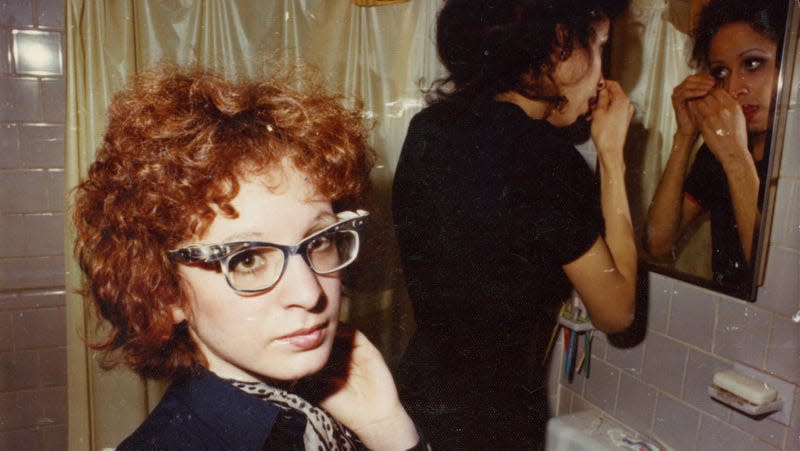All The Beauty And The Bloodshed brings two distinct worlds into sharp focus

- Oops!Something went wrong.Please try again later.
Nan Goldin (left) in All The Beauty And The Bloodshed
At some point in the future—if we are not there already—every artist who made their mark in the 20th century will have a documentary made about them. Most will be informative in the Wikipedia/“American Masters” sense, interesting to the people who already have an interest.
There was a stretch when these films were borderline therapy sessions for children of notable people (e.g. The Ballad Of Ramblin’ Jack by folk singer Jack Elliot’s daughter or My Architect by architect Louis Kahn’s son). Others have successfully taken a hyper-specific viewpoint, like Gerhard Richter Painting (that last word is a verb, not a noun) or Can’t Stand Losing You: Surviving The Police, which juxtaposes rock guitarist Andy Summers (hitherto considered the least interesting member of The Police) and his “direct-from-Babylon” archive photos he took from concert tours of yore.
Read more
Laura Poitras’ film about photographer Nan Goldin, All The Beauty And The Bloodshed, is interesting because it is essentially two films in one that, at the end, combine to create a full picture of its subject. It is extremely clever and deeply moving, and winningly gets at the essence of Goldin’s current and past work, without straining too hard to ape her style. The movie, which won the top prize at the Venice Film Festival (extremely rare for a documentary), is among the best of the year in any category.
Goldin may seem, at first, a notch down in gravitas for a typical Poitras subject. Her previous films have profiled Edward Snowden (Citizenfour), Julian Assange (Risk), and people with direct ties to Osama bin Laden (The Oath). One would not expect a shutterbug who came to prominence shooting drag queens at loft parties to be next on the list.
This is not to in any way negate that earlier work (there is ample evidence in All The Beauty And The Bloodshed of just how much of Goldin’s resume rules), but the 69-year-old artist currently has a new pursuit: an activist against the loathsome Sackler family. And she is getting results.
The Sacklers, of course, are the billionaires behind Purdue Pharma, the company that manufactured OxyContin, lying to physicians about its danger. (Check out the series Dopesick if you want to get sick to your stomach.) Goldin herself got hooked on the stuff after a surgical procedure, and nearly died. She then realized that she had a unique opportunity to hit the family in a way few others could: she could use her clout as a contemporary artist to shame art institutions that have, for years, taken donations from the Sacklers in exchange for naming rights. After staging elaborate (and, it should come as no surprise, very camera-ready) protests at spots like the Guggenheim Museum, Metropolitan Museum of Art, and the Victoria and Albert Museum, her group (and ones aligned with her) were able to make definitive changes. (Good luck finding the “Sackler Wing” at a lot of these places now.) The Sacklers, while considered culpable by many courts, have gotten away largely scot-free via loopholes in almost every arena other than in the art world.
All the Beauty and the Bloodshed - Official Trailer (2022) Nan Goldin
Riding with Goldin and company while taking direct action is played in counterpoint with a look back at her biography. Luckily, most of Goldin’s life (at least the really cool stuff) has already been carefully curated—it’s been the source for her artwork. Her breakthrough was putting together a “happening” called The Ballad Of Sexual Dependency, a slideshow of her photographs of downtown characters set to music in a cool space. No two projections were ever the same, and she fed off the response from one night to make changes to the next. Those who attended were there, in part, to see themselves, but they then went off to make art and films and live robust lives, inspired by the show. Goldin’s work became the eye of a self-replicating hurricane.
Poitras takes her time going through these images (sometimes set to the music that was actually used at the time, like the Velvet Underground and Screamin’ Jay Hawkins) but more often than not the counterpoint in sound is new interview footage of Goldin being honest about her not-too-terrific upbringing. While none of it has been kept secret in her work—like the suicide of her older sister, the very Eisenhower-conformist attitudes of her parents, her queer awakening, and previous bouts of addiction—it all comes to a substantial revelation at the climax. In short, while the movie seems to be going in two unrelated directions, there has been great consistency in her life’s great work. (You can, and should, watch the movie for yourself to put together the pieces.)
All The Beauty And The Bloodshed is a profound film, but it is also a good deal of fun (provided you are not too uptight.) Nan Goldin isn’t a shock artist, per se, but elements of her life are a bit shocking. How she paid for the cab ride from the Bowery to a midtown gallery to schlep boxes of photos did get something of a “come again?” out of me. Poitras’ other movies may seem on the surface to be more “important,” but this is certainly her most watchable.
More from The A.V. Club
Sign up for The A.V. Club's Newsletter. For the latest news, Facebook, Twitter and Instagram.

